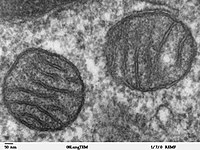
Photo from wikipedia
The targeting of bioactive molecules and probes to mitochondria can be achieved by coupling to the lipophilic triphenyl phosphonium (TPP) cation, which accumulates several hundred‐fold within mitochondria in response to… Click to show full abstract
The targeting of bioactive molecules and probes to mitochondria can be achieved by coupling to the lipophilic triphenyl phosphonium (TPP) cation, which accumulates several hundred‐fold within mitochondria in response to the mitochondrial membrane potential (Δψm). Typically, a simple alkane links the TPP to its “cargo”, increasing overall hydrophobicity. As it would be beneficial to enhance the water solubility of mitochondria‐targeted compounds we explored the effects of replacing the alkyl linker with a polyethylene glycol (PEG). We found that the use of PEG led to compounds that were readily taken up by isolated mitochondria and by mitochondria inside cells. Within mitochondria the PEG linker greatly decreased adsorption of the TPP constructs to the matrix‐facing face of the mitochondrial inner membrane. These findings will allow the distribution of mitochondria‐targeted TPP compounds within mitochondria to be fine‐tuned.
Journal Title: ChemBioChem
Year Published: 2023
Link to full text (if available)
Share on Social Media: Sign Up to like & get
recommendations!